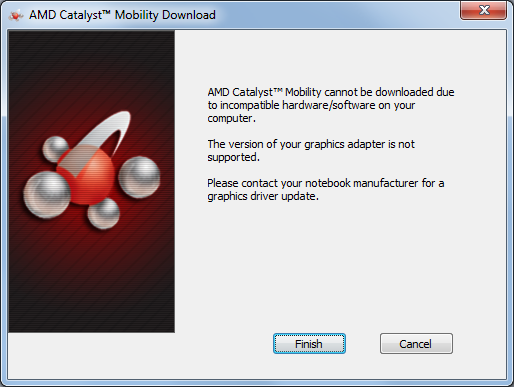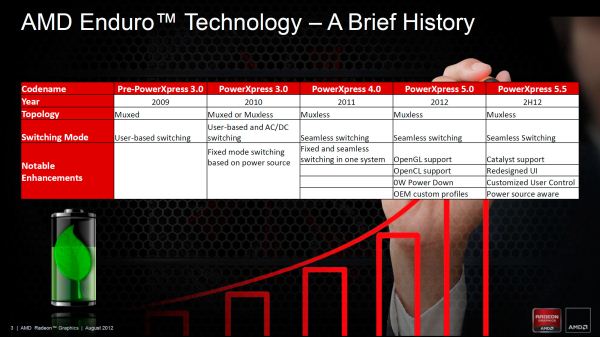AMD’s Enduro Switchable Graphics Levels Up
by Jarred Walton on September 6, 2012 3:00 AM ESTRecap: AMD’s PowerXpress, aka Dynamic Switchable Graphics, aka Enduro
Getting back to the switchable graphics, AMD has gone through a variety of names over the years. Here’s AMD’s summary slide, which I’ll discuss in detail:
Originally introduced as PowerXpress back in 2008, the first AMD switchable graphics solutions were like that found later in the ASUS UL80Vt and similar laptops: you had to flip a switch, and in the first iterations you would then need to reboot the laptop so that the BIOS could disable the discrete GPU and activate the integrated GPU. It was messy and a bit inconvenient, and NVIDIA’s early studies showed that many users ended up not using the feature—they would either run on dGPU all the time or on iGPU all the time. Both AMD and NVIDIA had a second series of switchable graphics designs where the need to reboot was removed; the first Alienware M11x could switch GPUs in about 10-15 seconds, and the same was true of HP’s first ENVY laptops. These were using PowerXpress 2.0 and 3.0, and for most people the switching side was adequate: you’d run on dGPU when plugged in and switch to iGPU when on battery power.
Last year, AMD took a step forward with their switchable graphics by introducing PowerXpress 4.0, which also renamed the technology to Dynamic Switchable Graphics (DSG for short). I got a chance to do a head-to-head of the technology using a Sony VAIO C laptop provided by NVIDIA. You know a company is confident that they’re going to win a technology comparison when they’ll actually give you a competitor’s product. In some cases, DSG was just as good as Optimus: you could launch a supported game and never realize all the extra stuff happening in the background; unfortunately, there were several titles where it wasn’t quite as convenient as we would have liked, and OpenGL support from DSG was completely missing.
Step forward to early 2012 and we got another update to PowerXpress 5.0 (note that PowerXpress is now only used internally by AMD and hasn’t been their marketing name since before PX4.0) along with a rechristening: Dynamic Switchable Graphics was out and Enduro was in. If nothing else, at least it makes my job easier as Enduro is much more concise. There's also the fact that the GPUs are no longer "switching", as the iGPU is always running; now the dGPU is simply supplementing the iGPU when needed. Along with the name change, AMD added OpenGL and OpenCL support to the mix, and with their Zero Core Technology (which is also part of their 7000 series desktop GPUs—a case of mobile design influencing desktops) the need to keep a small portion of the chip alive (aka BACO: Bus Active Chip Off) was removed. OEMs could also ship with custom profiles for applications, so for example Dell might want all of their extra utilities to default to running on the iGPU.

Hopefully this problem goes away next month!
Other than those changes, the UI and driver updates situation on early Enduro solutions remains largely the same as with DSG/PX4.0—and that’s what I initially received with the Clevo P170EM, with drivers from around March 2012. A quick check at AMD’s site also let me know that there weren’t any new drivers available, as the P170EM wasn’t currently supported by the latest Mobility Catalyst drivers.











200 Comments
View All Comments
Ryan Smith - Thursday, September 6, 2012 - link
Your comment will not be deleted. We do not delete comments except for spam.prophet001 - Thursday, September 6, 2012 - link
This isn't Clevo's support thread :/Seanzky - Thursday, September 6, 2012 - link
Thank goodness, because we want AMD to hear about their Enduro issues. Not Clevo.hulawafu77 - Thursday, September 6, 2012 - link
Amen to that. Clevo is not at fault for this. This is about AMD's complete lack of driver support for mobile GCN. I hope others reading get that through their head, this is not an OEM issue, this is completely AMD's 100% fault here.arcticjoe - Thursday, September 6, 2012 - link
this issue affects virtually all 7000 series laptop cards that use muxless design. Naturally this bottleneck is the most visible on 7970m because its the fastest card, so most vocal users will be 7970m users.sirizak - Thursday, September 6, 2012 - link
The only laptop that gets around this is the Alienware, as it has a hardware switch to force the dedicated graphics instead of the faulty implementation Clevo and AMD are serving up here.I'm just glad to see this sugject finally getting dragged to the surface here, Hopefully this might motivate AMD to come to the party with quick solution.
It would be a shame to see a great product like the 7970m goto the junk pile because of their lack of support.
JarredWalton - Thursday, September 6, 2012 - link
There are no "quick fix" solutions for complex problems. As for the Alienware, the interesting thing is that it has hardware muxes so you can turn off the integrated graphics (so the display outputs get routed directly to the dGPU). Why would they do that when they have Enduro? Probably because they don't like the way Enduro works right now but they wanted to give users the option of getting better battery life. How's that for confidence?hulawafu77 - Thursday, September 6, 2012 - link
Yep, just go to NBR or Guru3D. There are HP owners who are suffering from this and Lenovo and Dell that aren't AW. Anyone using Enduro is affected if they can't disable it in the BIOS.Pixelpusher6 - Thursday, September 6, 2012 - link
Wow I didn't realize there were so many problems with AMD's Enduro solution. I knew that Nvidia's Optimus solution was far superior but I didn't know about all the problems with Enduro for 7970m users. Once again I think this shows very questionable management at AMD. I have been saying for the last 6 months that AMD has been making very poor management decisions and this is another one of those. Instead of trying to sweep it under the rug the AMD support staff should be working with users to pinpoint the problem. I'm sure it is something that can be fixed with some new drivers, unless AMD knows something we don't and that is why they are trying to bury it.Seanzky - Thursday, September 6, 2012 - link
Before anyone brands me as "AMD-hating" please know that this is purely speculation on my part. AMD, being relatively smaller compared to nVidia, can only focus so much of their resources by looking into this issue. They can't be a step behind in the race for the next gen GPU. So the question is: will they split their resources to support their paying customers (me among many) or will they just sweep this under the rug and focus all their manpower to fix Enduro in the next series?AMD is lucky that I am willing to chuck this up as an expensive lesson learned. I am most likely not going to be buying AMD in the near future as I do have enough funds for upgrading my laptop. The same can't be said for other 7970M owners, though. There are many tight-budgeted college students who bought into AMD's flagship card.